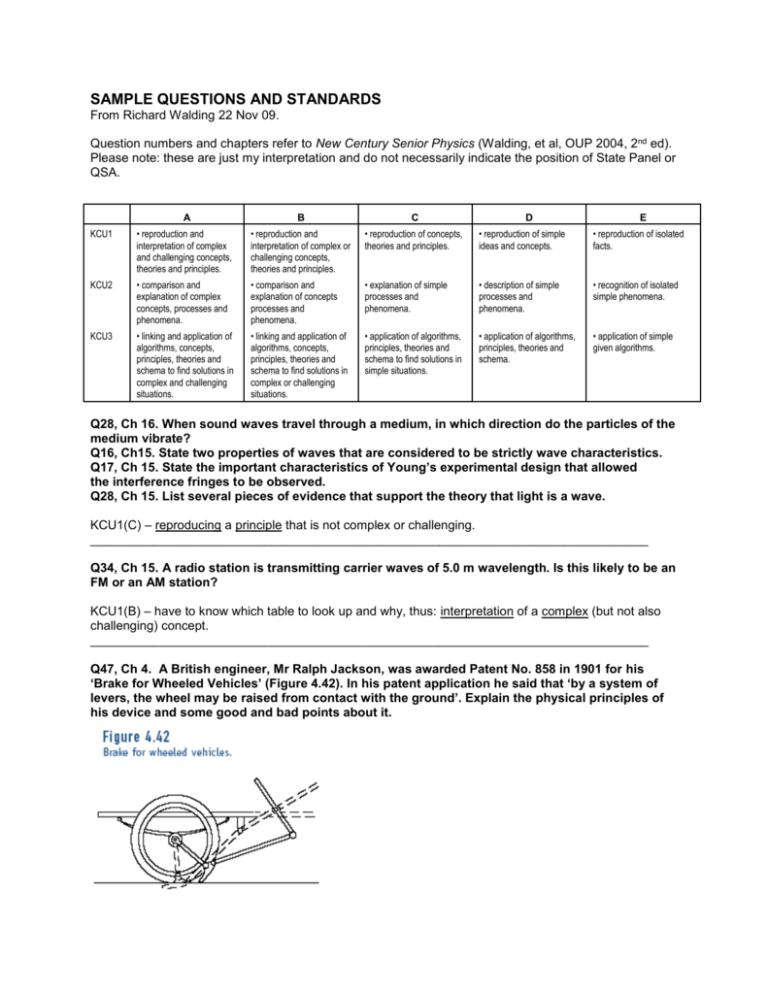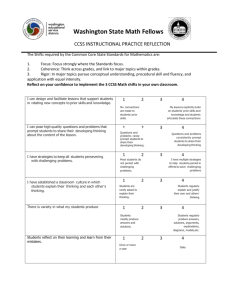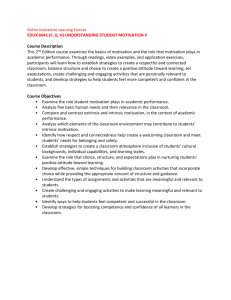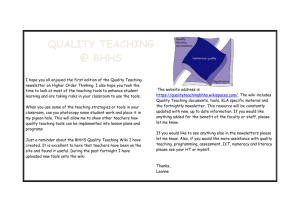Deciding criteria and standards
advertisement

SAMPLE QUESTIONS AND STANDARDS From Richard Walding 22 Nov 09. Question numbers and chapters refer to New Century Senior Physics (Walding, et al, OUP 2004, 2nd ed). Please note: these are just my interpretation and do not necessarily indicate the position of State Panel or QSA. A B C KCU1 • reproduction and interpretation of complex and challenging concepts, theories and principles. • reproduction and interpretation of complex or challenging concepts, theories and principles. • reproduction of concepts, theories and principles. • reproduction of simple ideas and concepts. D • reproduction of isolated facts. E KCU2 • comparison and explanation of complex concepts, processes and phenomena. • comparison and explanation of concepts processes and phenomena. • explanation of simple processes and phenomena. • description of simple processes and phenomena. • recognition of isolated simple phenomena. KCU3 • linking and application of algorithms, concepts, principles, theories and schema to find solutions in complex and challenging situations. • linking and application of algorithms, concepts, principles, theories and schema to find solutions in complex or challenging situations. • application of algorithms, principles, theories and schema to find solutions in simple situations. • application of algorithms, principles, theories and schema. • application of simple given algorithms. Q28, Ch 16. When sound waves travel through a medium, in which direction do the particles of the medium vibrate? Q16, Ch15. State two properties of waves that are considered to be strictly wave characteristics. Q17, Ch 15. State the important characteristics of Young’s experimental design that allowed the interference fringes to be observed. Q28, Ch 15. List several pieces of evidence that support the theory that light is a wave. KCU1(C) – reproducing a principle that is not complex or challenging. ________________________________________________________________________________ Q34, Ch 15. A radio station is transmitting carrier waves of 5.0 m wavelength. Is this likely to be an FM or an AM station? KCU1(B) – have to know which table to look up and why, thus: interpretation of a complex (but not also challenging) concept. ________________________________________________________________________________ Q47, Ch 4. A British engineer, Mr Ralph Jackson, was awarded Patent No. 858 in 1901 for his ‘Brake for Wheeled Vehicles’ (Figure 4.42). In his patent application he said that ‘by a system of levers, the wheel may be raised from contact with the ground’. Explain the physical principles of his device and some good and bad points about it. KCU1(A) – interpret in a complex (multistep) and challenging (unfamiliar) situation. ________________________________________________________________________________ Q12, Ch 20. Why do you think doctors shine a light in your eyes to see if you are conscious? KCU2(C) - explanation of a simple process (if alive, pupil contracts in bright light). ________________________________________________________________________________ Q31, Ch 16. Explain how sounds can have the same pitch but different qualities. KCU2(B) – if unrehearsed, the question asks for an explanation and comparison of overtones (noncomplex concept). If rehearsed then probably “explanation of simple phenomena”, thus KCU2(C). ________________________________________________________________________________ Q42, Ch 16. Discuss the possibility of open-ended organ pipes producing different frequency notes on hot or cold days. KCU2(B) – assuming this is not a rehearsed question, it requires a comparison (hot and cold days) and explanation of (non-complex) phenomena (change of speed of sound in air with temperature). ________________________________________________________________________________ Q31, Ch 20. In William Golding’s Lord of the Flies the character Piggy uses his glasses to start a fire. Later the boys break Piggy’s glasses but he cannot identify them at close range because he is short-sighted. Find the flaw in this narrative. KCU2(A) - comparison (fire and sight) and explanation (convex lens to focus light; concave lens for short sight) of complex concepts (image formation), processes (use of lenses to suit different purposes) and phenomena (light fire, enhance vision). ________________________________________________________________________________ Q26, Ch 8. A car of mass 2200 kg accelerates from rest at 3 m s–2 for 10 s. Determine the impulse imparted to the car. KCU3 (C). Finding solution in a simple situation (that students would have rehearsed). ________________________________________________________________________________ Q32, Ch 8. A ball A of mass 6 kg is moving east at 3.5 m s–1 when it collides with a stationary ball B of mass 8 kg. Ball A heads north at 5 m s–1 after the collision. Determine the final velocity of ball B. KCU3 (B). Complex (multistep) situation but not that challenging (novel, unfamiliar). ______________________________________________________________________________ Q33, Ch8. The ballistocardiograph (BCG) is an important device in medicine and is designed to employ simple physics to analyse the effectiveness of operations on a patient’s heart. With each heartbeat, about 70 g of blood is ejected from the left ventricle of the heart into the aorta (Figure 8.39). The speed of the blood is about 30 cm s–1. Hence the blood from each heartbeat has momentum. The body recoils with each heartbeat due to conservation of momentum. This can be registered on a very sensitive balance attached to the platform on which the body rests. (See Figure 8.40). Fig 8.39 Fig 8.40 (a) When the body recoils, the table moves. How has friction been taken into account? KCU1, 2, 3(B) – reproduction and interpretation and explaining concepts and finding solutions to a challenging (novel, unfamiliar) situation but not complex (multistep) concepts or situations. (b) When a pulse of blood travels from ventricle to aorta, which way would the body move? KCU1, 2, 3(B) – reproduction and interpretation and explaining concepts and finding solutions to a challenging (novel, unfamiliar) situation but not complex (multistep) concepts or situations. (c) On the graph, the acceleration goes negative after the main part of the heartbeat. Why is this? KCU1, 2, 3(B) – reproduction and interpretation and explaining concepts and finding solutions to a challenging (novel, unfamiliar) situation but not complex (multistep) concepts or situations. (d) An acceleration of about 0.06 m s–2 is considered healthy. What is the value for the heart attack victim? KCU1, 2, 3(B) – reproduction and interpretation and explaining concepts and finding solutions to a challenging (novel, unfamiliar) situation but not complex (multistep) concepts or situations. (e) Extract the information needed to calculate the momentum of a blood pulse and calculate it. KCU1, 2, 3(B) – reproduction and interpretation and explaining concepts and finding solutions to a challenging (novel, unfamiliar) situation but not complex (multistep) concepts or situations. However, taken as a whole, this question could be considered KCU1,2,3 (A) as it is challenging (novel, unfamiliar) and the number separate ideas make it complex as a whole. The questions do not give hints for subsequent questions (which would reduce its complexity). Standard “A”: all five parts answered correctly (complex and challenging). Standard “B”: Perhaps three parts answered correctly (less complexity, but still challenging) Standard “C” Simple ideas stated correctly. ________________________________________________________________________________ Q37, Ch8. A rocket of mass 25 000 kg is cruising through space with a constant speed of 1 × 10 3 m s–1 when exhaust gases are expelled for 10.0 seconds at a rate of 500 kg s–1 with a speed of 5 × 104 m s–1. Calculate the new speed of the rocket. Assuming this hasn’t been practiced in class (therefore unfamiliar): KCU 1, 3 (A) – reproduction and interpretation and finding solutions to a challenging (novel, unfamiliar) and complex (multistep) concepts or situations. ________________________________________________________________________________ Q40, Ch 28. The activity of a sample of a beta-emitting phosphorus nuclide was measured and the count was corrected for background radiation. The results were as shown in Table 28.13. Plot ln A vs t for these data and determine the half-life of the phosphorus. A B C D KCU3 • linking and application of algorithms, concepts, principles, theories and schema to find solutions in complex and challenging situations. • linking and application of algorithms, concepts, principles, theories and schema to find solutions in complex or challenging situations. • application of algorithms, principles, theories and schema to find solutions in simple situations. • application of algorithms, principles, theories and schema. • application of simple given algorithms. E IP3 • systematic analysis of primary and secondary data to identify relationships between patterns, trends, errors and anomalies. • analysis of primary and secondary data to identify patterns, trends, errors and anomalies. • analysis of primary and secondary data to identify obvious patterns, trends, errors and anomalies. • identification of obvious patterns and errors. • recording of data. EC1 • analysis and evaluation of complex scientific interrelationships. • analysis of complex scientific interrelationships. • description of scientific interrelationships. • identification of simple scientific interrelationships. • identification of obvious scientific interrelationships. KCU3 (B). Typically, this sort of problem would have been done in class beforehand. In this case it is complex as there are quite a few steps to get to the answer, but it is not challenging as it has been rehearsed (familiar); hence “B” as it is a complex OR challenging situation. IP3 (B). Data are provided and the graph to be plotted is stated so no systematic analysis is required; hence not an “A”. The (linear) pattern should be expected so the relationship would be fairly obvious, however, the analysis will require a line of best fit and ways of dealing with outliers which makes the pattern less obvious; hence a “B”. EC1 (B). The relationship is complex as it requires a log graph to confirm the relationship and it has to be analysed to get the half-life (the slope has to be determined) and not just described (eg linear); hence a “B” standard rather than a “C”. There is no requirement to evaluate the relationship so it is not an “A” ________________________________________________________________________________ BRAND: MODEL MASS CAPACITY BOILING POWER Q34, Ch22. Electric kettles range in power from 1000 W to 2500 W. The rating is usually stamped underneath. Table 22.6 has been taken from Choice magazine and compares the performance of 10 different cordless kettles. (a) Plot a graph to determine if there is any relationship between power consumption and the boiling time for 1 L of water. Describe the relationship. KCU1(A) - reproduction and interpretation of the complex and challenging principle that the curve cannot possibly be linear in practice as it would still boil with zero power consumption. KCU2(A) – comparing and explaining the complex concepts regarding power and boiling time. KCU3(A) - linking and application of algorithms (regression analysis or curve fitting), concepts (conservation of energy in transfer from electricity to heat), principles (calorimetry), theories (mcΔT = Pt) and schema (solution by graphing) to find solutions in complex and challenging situations. IP3(A) – the graph is not “obviously” a linear one and in fact (given time and effort) it can be shown to be linear: y = 0.0832x + 353; or exponential: 255000x-0.949. This would require systematic plotting of data and curve fitting (analysis), and identifying the relationship; EC1(A) - and analysis and evaluation of the complex relationship. (b) Estimate the boiling times of a 1600 W kettle and a 2400 W kettle. KCU3(C) - application of schema to find solutions in simple situations (extrapolation and interpolation). If done by algebra may indicate “A” or “B” level. (c) The efficiency of a kettle can be calculated by the formula: efficiency = × 100%. The “power in” is shown in the table as ‘Power consumption’. The “power out” can be calculated from data about heating up the water. Assume that the water started at a temperature of 25°C. Calculate the efficiency of each kettle and make a rank order of them. Are the high powered kettles the most efficient? (Hint: the efficiency of the Linda Superboil is 84%.) KCU1, 2(A) - reproducing and interpreting complex and challenging concepts. KCU3(A) -– applying algorithms (Q= mcΔT, P = W/t, %Eff = Pin/Pout x 100) to complex and challenging situations (as established before). IP3(B) – systematic analysis to identify relationship between trends (in power and efficiency). A B C D E IP3 • systematic analysis of primary and secondary data to identify relationships between patterns, trends, errors and anomalies. • analysis of primary and secondary data to identify patterns, trends, errors and anomalies. • analysis of primary and secondary data to identify obvious patterns, trends, errors and anomalies. • identification of obvious patterns and errors. • recording of data. EC1 • analysis and evaluation of complex scientific interrelationships. • analysis of complex scientific interrelationships. • description of scientific interrelationships. • identification of simple scientific interrelationships. • identification of obvious scientific interrelationships.






